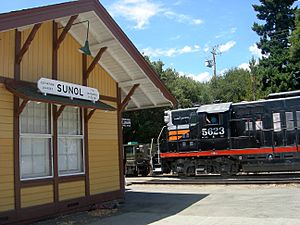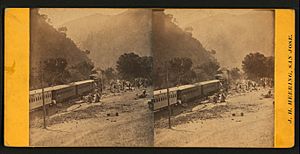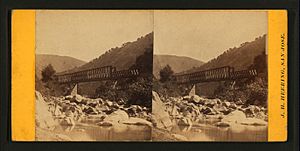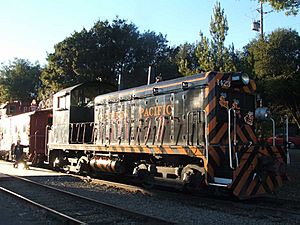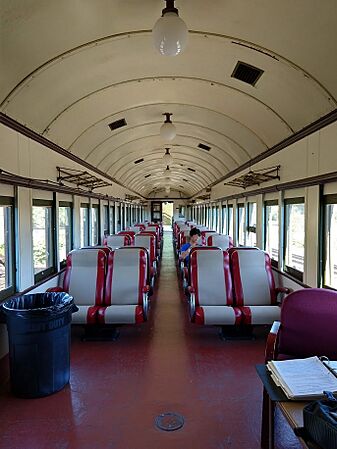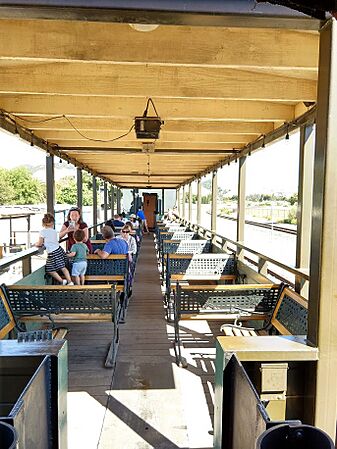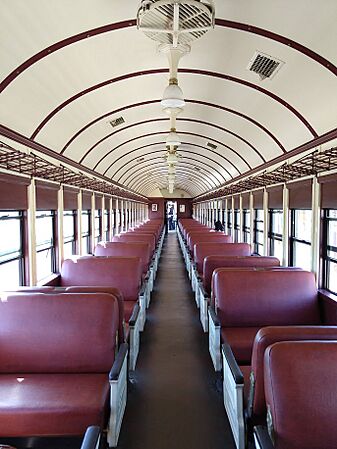Niles Canyon Railway facts for kids
Quick facts for kids Niles Canyon Railway |
|
|---|---|
 |
|
| Locale | Alameda County, California, USA |
| Commercial operations | |
| Built by | Western Pacific Railroad (1862-1870) |
| Original gauge | 4 ft 8 1⁄2 in (1,435 mm) standard gauge |
| Preserved operations | |
| Owned by | Alameda County |
| Operated by | Pacific Locomotive Association |
| Reporting mark | NICX |
| Stations | 2 (plus 1 planned) |
| Length | 9.2 mi (14.8 km) |
| Preserved gauge | 4 ft 8 1⁄2 in (1,435 mm) standard gauge |
| Commercial history | |
| Opened | 1869 |
| Closed | 1984 |
| Preservation history | |
| 1987 | Lease from County and start of reconstructiom |
| 1988 | Began operation |
| Headquarters | Fremont, California |
| Website | |
| http://www.ncry.org/ | |
|
Niles Canyon Transcontinental Railroad Historic District
|
|
| Area | Approximately 200 acres |
| Built | 1865–1869 |
| Architectural style | Other-standard gauge railroad; Other-Warren Truss (bridge); Other-Pratt Truss (bridge); Stick (depot) |
| NRHP reference No. | 10000843 |
| Added to NRHP | October 13, 2010 |
The Niles Canyon Railway (NCRy) is a special historic railway. It runs through Niles Canyon, between Sunol and the Niles area of Fremont. This area is in the East Bay part of the San Francisco Bay Area, in California, United States.
This railway is so important that it's listed on the National Register of Historic Places. It's known as the Niles Canyon Transcontinental Railroad Historic District. The railway is run by a group called the Pacific Locomotive Association. They work hard to save, fix, and operate old railroad equipment. The NCRy offers fun public train rides using both old steam and diesel engines. These rides take you along a well-preserved part of the First Transcontinental Railroad.
Contents
A Journey Through Time: The History of the Railway
The Niles Canyon Railway runs on a section of the First Transcontinental Railroad. This famous railroad was built in the 1860s. The train line through Niles Canyon was one of the first built in California. It created the first train connection between San Francisco Bay and the rest of the country!
Building the Tracks
In 1862, a law called the Pacific Railroad Act allowed two companies, the Central Pacific Railroad and the Union Pacific Railroad, to build a railroad across the country. The Central Pacific Railroad made a deal with the first Western Pacific Railroad (not the later company with the same name). Their job was to build the western part of the line. This connected the Central Pacific in Sacramento to San Jose. Trains could then go on to San Francisco.
By 1866, the Western Pacific had built about 20 miles (32 km) of track. This reached halfway into what was then called Alameda Cañon. They used 500 Chinese laborers to build the tracks through the tough canyon. The work stopped for a while due to problems.
In 1869, the Central Pacific Railroad took over the project. They also used Chinese laborers to restart work in Alameda Cañon. By August 1869, the railroad through Alameda Cañon was finished. It went eastward to Pleasanton and into Livermore Valley.
In September 1869, the railroad from Sacramento through Alameda Cañon to the Alameda Terminal was complete! The first Western Pacific train ran through the canyon on September 6, 1869. This was a big deal, as it connected the transcontinental railroad to the Pacific coast. This happened four months after the Central Pacific and Union Pacific lines met in Utah. Later, a bigger terminal opened in Oakland Long Wharf. From there, ferries took passengers to San Francisco until 1958.
At the entrance of Alameda Cañon, two train lines met. One went to Oakland and the other to San Jose. To make the most of this, Central Pacific built a large train station. It even had a restaurant for passengers. They named the station in 1870 after their lawyer, Addison Niles. Because of this, the area became known as Niles. And Alameda Cañon became known as Niles Canyon.
How the Railroad Was Used
When it was first built, the train line through Niles Canyon was the main way for trains to travel to and from the San Francisco Bay. Later, a shorter train line between Oakland and Sacramento was built by 1879. This meant the Niles Canyon line was used less often.
However, in the early 1900s, the Southern Pacific Railroad (which took over Central Pacific) made big changes. There was too much freight traffic for the ferries to handle. So, they improved the Niles Canyon line. They replaced old wooden bridges with strong steel ones. The small town of Niles became an important junction. Freight from the San Francisco Peninsula and farm products from the Santa Clara and Salinas Valleys traveled through the canyon. Many of the original stone walls and bridges built by Chinese laborers in the 1860s can still be seen today.
Saving the Railway
Over time, less freight was shipped by train. Trucks on highways became more popular. So, the Southern Pacific Railroad stopped using the Niles Canyon line in 1984. They gave the land to Alameda County.
Then, the Pacific Locomotive Association stepped in. They leased the railway from the county and began fixing the tracks in 1987. The Niles Canyon Railway ran its first passenger train from Sunol on May 21, 1988. By April 9, 2006, passenger trains were running all the way between Sunol and Niles again! The group continues to work on extending and taking care of the tracks. They also fix up their collection of old train equipment. Their goal is to eventually extend their train service to Pleasanton, California.
Niles Canyon Historic District
The Niles Canyon Railway, its tracks, and its old buildings were added to the National Register of Historic Places on October 13, 2010. This means they are recognized as very important historical sites. The railway is special because it shows great railroad engineering from the past. It also played a big part in building the original Transcontinental Railroad. It was an important freight railway in the early 1900s.
The "Period of Significance" for this district is from 1865 to 1958. This time frame covers when the railroad was built and when it was a major transportation route.
The historic district includes many important items built between 1865 and 1958. These are called "contributing resources." They include the tracks, the graded roadbed, culverts (water tunnels), bridges, signals, and old telegraph lines. Things built or changed after 1958 are called "non-contributing resources."
Here are some of the main historic parts of the railway:
- Sunol Depot This old train station was built in 1884. Railroads like the Southern Pacific built standard station designs. This helped them save money and made things predictable for workers and customers. The Sunol Depot is a "combination depot." This means it had offices for the train agent, a place for freight, and a waiting room for passengers all in one building. It's the last one of its kind still standing! It's 19 feet (5.8 m) wide and 67 feet (20 m) long. The station had different rooms for different jobs. There was a waiting room for passengers and an agent's office. The agent's office had a bay window to see the tracks. There was also a baggage room and a freight room. The freight room was raised so it would be level with train cars for easy loading. Today, the freight room is used for exhibits and meetings.
- Dresser Bridge The current Dresser Bridge has two early examples of special metal bridges called "Warren through truss" structures. These were made in 1906. They replaced older wooden bridges. The original stone supports for the bridge, built in 1865–66, are still used today!
- Farwell Bridge This bridge has a main metal "Pratt through pin-connected truss" from 1896. It also has other parts added later. The original stone supports for two of the bridge's piers date back to 1865–66.
- Arroyo de la Laguna Bridge This bridge is made of five metal plate girder sections. It replaced an older wooden bridge in 1899. The stone supports and two of the piers from the original construction are still there.
Fun Train Rides
The Niles Canyon Railway offers train rides on certain days throughout the year. They usually run on the first and third Sundays from January to March and September to October. From April to August, they run on the first and third Saturdays and Sundays. They often switch between using steam locomotives and diesel locomotives. You can ride in open or enclosed passenger cars. Check their website for exact schedules and special events!
You can also book private group trips. During the Christmas season, they have special "Train of Lights" trips.
Passengers can board the train at the Niles station site in Fremont. This is near the Union Pacific Coast Line, where Amtrak trains run. There's also the unrelated Niles Depot Museum nearby, which has model railroads. You can also board at the historic 1884 Sunol depot. This depot is the last example of a Southern Pacific standard Combination Depot #7. Future plans for the Sunol Depot include educational displays.
Amazing Railroad Equipment
The Pacific Locomotive Association has a large collection of trains! They have 9 steam locomotives and 13 diesel locomotives. Plus, they have over 40 other pieces of rolling stock (train cars).
Cool Steam Locomotives
| Name | Status | Type | Builder | Date |
|---|---|---|---|---|
| Quincy Railroad Co. No. 2 | Stored | 2-6-2T | American Locomotive Company | 1924 |
| Robert Dollar Co. No. 3 | Operational | 2-6-2T | American Locomotive Company | 1927 |
| Clover Valley Lumber Company No. 4 | Operational | 2-6-6-2T | Baldwin Locomotive Works | 1924 |
| Pickering Lumber Co No. 5 | Stored | 3T Heisler | Heisler Locomotive Works | 1913 |
| Pickering Lumber Co No. 12 | Stored | 3T Shay | Lima Locomotive Works | 1903 |
| Sierra Railway No. 30 | Under restoration | 2-6-2 | Baldwin Locomotive Works | 1922 |
| Southern Pacific 1269 | Stored | 0-6-0 | Southern Pacific Railroad | 1921 |
| Southern Pacific 2467 | Stored & Loaned to CSRM | 4-6-2 | Baldwin Locomotive Works | 1921 |
| Southern Pacific 1744 | Under restoration | 2-6-0 | Baldwin Locomotive Works | 1901 |
Awesome Diesel Locomotives
| Name | Status | Builder / Model | Date |
|---|---|---|---|
| Atchison, Topeka and Santa Fe 462 | Stored | GE 44-ton switcher | 1943 |
| Oakland Terminal Railway 101 | Stored | Baldwin DS-4-4-1000 | 1948 |
| Southern Pacific 1218 | Under restoration | ALCO S-6 | 1955 |
| Southern Pacific 1423 | Operational | EMD NW2 | 1949 |
| Southern Pacific 5472 | Operational | EMD SD9 | 1956 |
| Southern Pacific 5623 | Operational | EMD GP9 "torpedo boat" | 1955 |
| Southern Pacific 9010 | Under restoration | KM ML-4000 | 1964 |
| U.S. Army 1856 | Operational | FM H-12-44 | 1953 |
| U.S. Army 7348 | Operational | GE 65-ton switcher | 1942 |
| Western Pacific 713 | Operational | EMD GP7 | 1953 |
| Western Pacific 918D | Operational | EMD F7 | 1950 |
| Southern Pacific 1195 | Operational | EMD SW900 | 1954 |
Passenger Cars
- Interior Views




